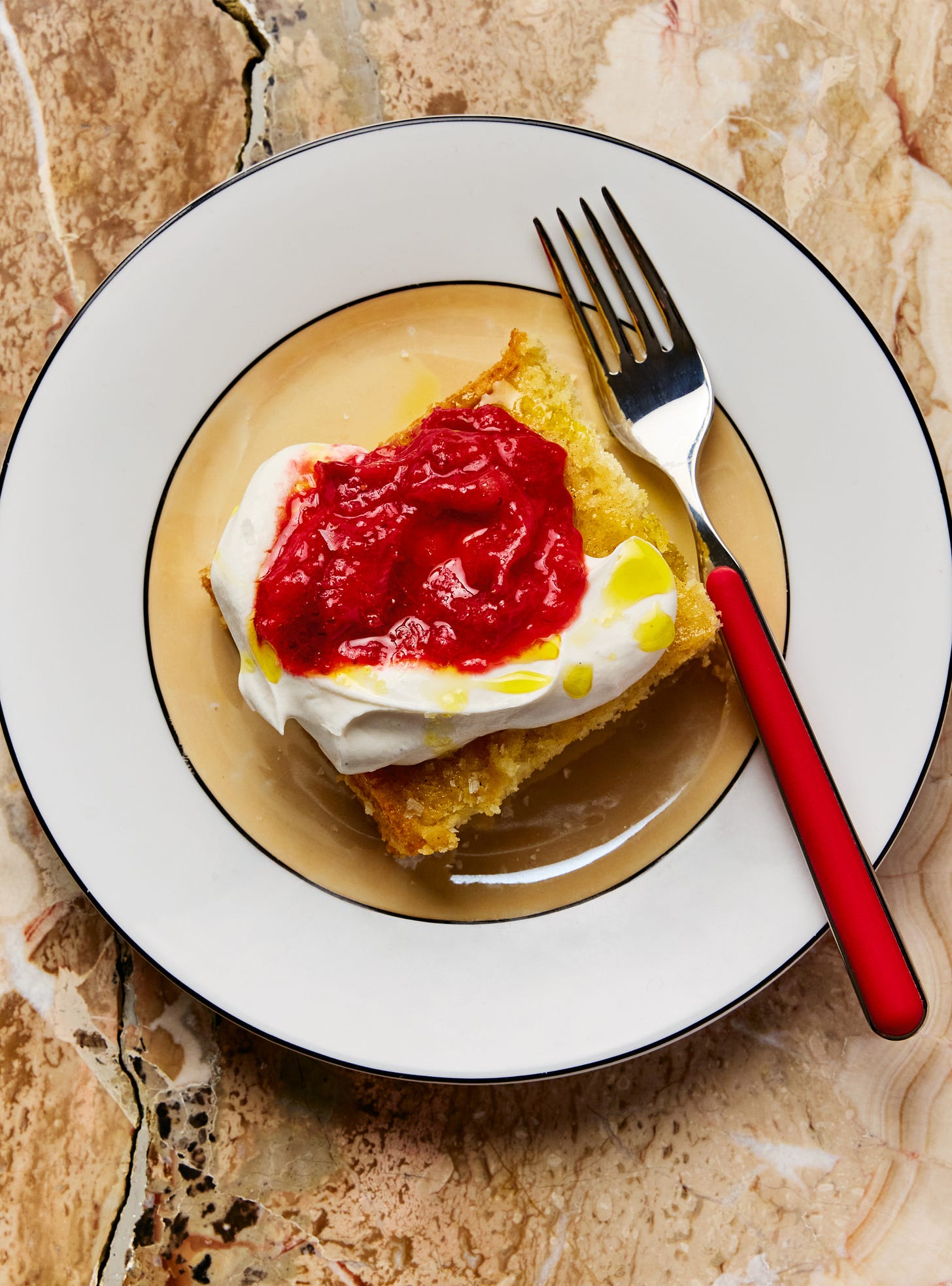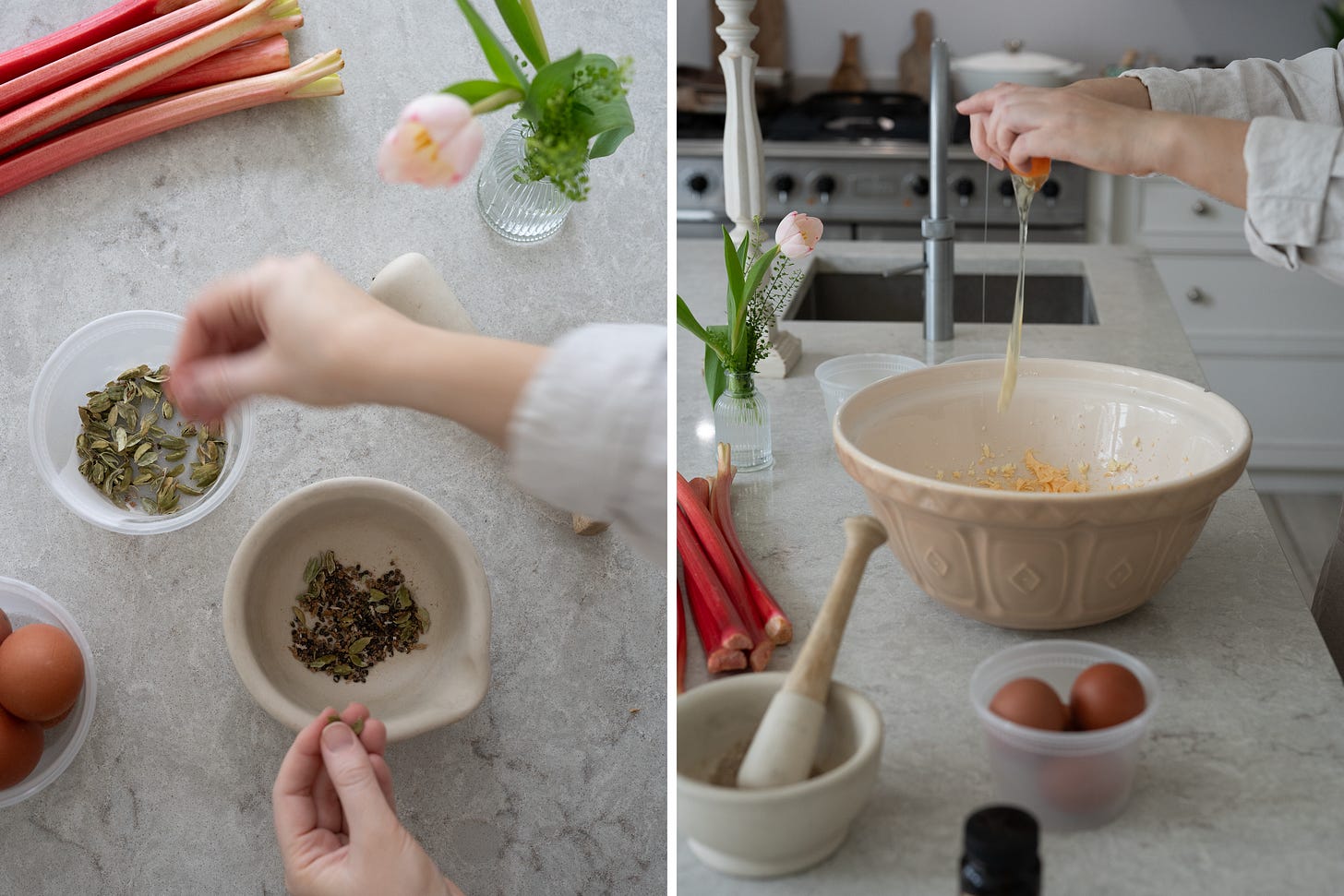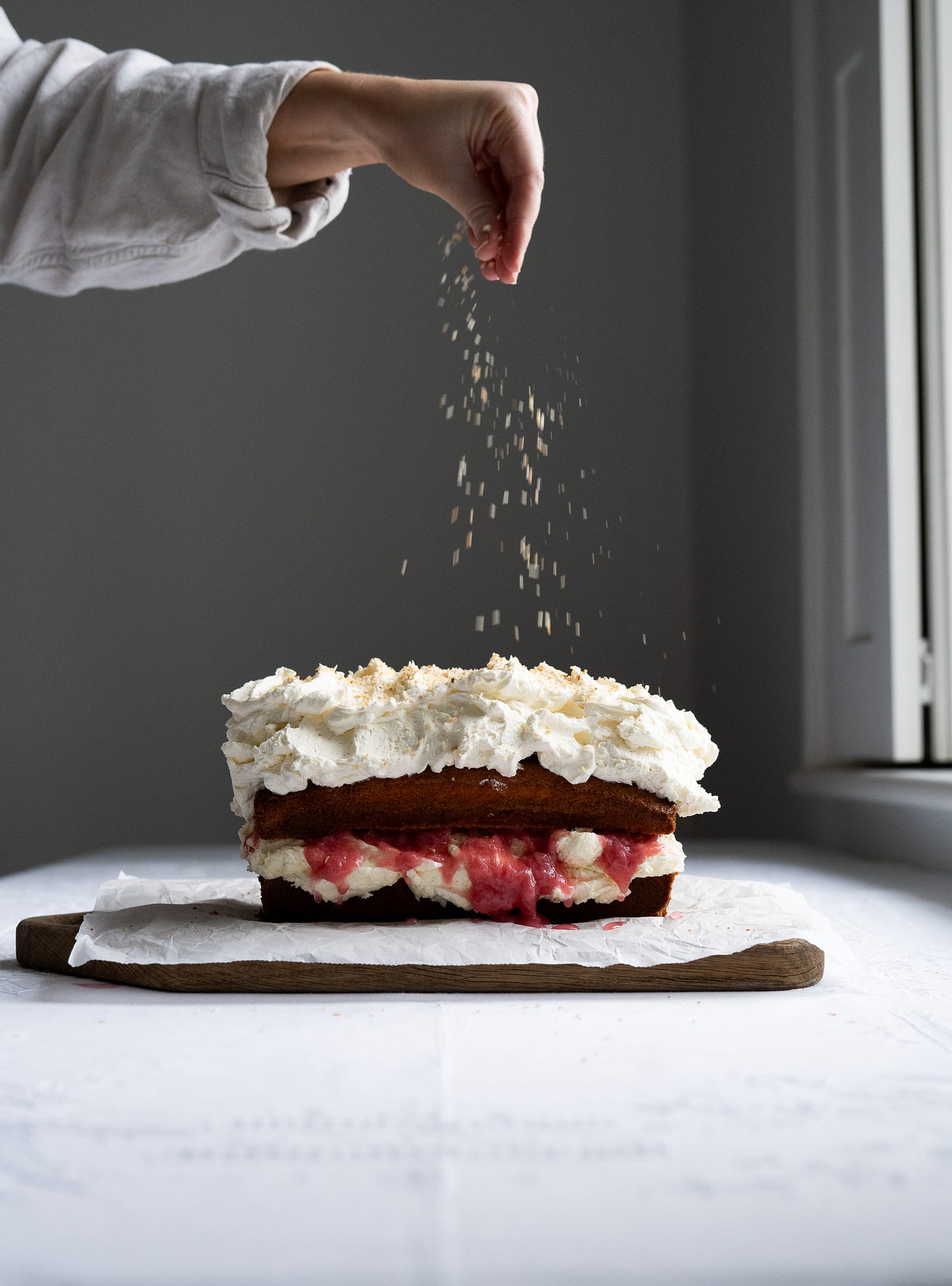& FRIENDS presents Zaynab Issa
Two exclusive recipes from Zaynab's forthcoming cookbook, Third Culture Cooking
The best recipes don’t just feed us - they stay with us, lingering like the scent of freshly ground cardamom caught in the grain of a wooden spoon. They carry the weight of history, tracing the paths of migration and memory, speaking in the language of spice and smoke. They tell us where we’ve been, who we are, and who we long to become - a reminder that food is both an act of preservation and reinvention. Zaynab Issa understands this instinctively.
debut cookbook, Third Culture Cooking isn’t merely a collection of dishes - it’s a homecoming. Each recipe is a thread in a larger tapestry, woven from the women who shaped her, the kitchens that raised her, and the flavors that live in her bones. A flick of a spice jar lid is an act of remembrance; a pot of garlic-laced tomato saag is a lesson in lineage. From the crisp, crackling ‘’labor of love’’ samosas to the quiet indulgence of a cream covered cardamom and coconut cake, Third Culture Cooking is a testament to tradition - revered and reimagined. Each dish carries the weight of heritage, yet is infused with the unmistakable spirit of Zaynab’s first-generation American voice - modern, intentional, and deeply personal.In this special first edition of & Friends,
reflects on the flavors that define her, the discipline she honed as associate food editor at Bon Appétit, and the unexpected discoveries that come with writing a cookbook.This is a rather long post, so feel free to view via the website or app if the email cuts out.
I wouldn’t let you go hungry, so today we’re sharing two exclusive recipes from the book (and yes, they’re truly exclusive - you won’t find them anywhere else until the book is released on the 1st April!): spiced short ribs and coconut cardamom cake. I highly recommend giving the recipes a try; together, they make the perfect weekend night dinner at home, balancing deep, warming spices with a touch of sweetness - a meal that feels both comforting and celebratory.
I prefer to let short ribs braise in the oven - out of sight, out of mind, as Zaynab says - but they’ll do just as well on the stovetop if you prefer to keep an eye on things. The recipe leans heavily on spice, so use the freshest you have; tired spices will dampen the depth.
calls for yellow onions, but I was out and reached for banana shallots instead; their extra sweetness played beautifully against the warm aromatics.As for serving, I stay loyal to British tradition: a deeply creamy mash (I include both heavy cream and a cheeky dollop of cream cheese) to offset the richness. But a fragrant coconut rice would be just as welcome. If you’re feeling indulgent, try shredding the rib meat into a bowl of pasta, topped with burrata - the cool, milky contrast against the spices is something quite special. You see, Zaynab writes recipes that invite interpretation and creative adaptation, so don’t be afraid to make them your own.
Okay, let’s discuss dessert! Recipes aren’t commandments; they’re friendly suggestions - meant to be adapted, expanded, and made your own - so I got a little creative with Zaynab’s cardamom and coconut cake. You’ll have noticed that lately I’ve been quietly obsessed with loaf cakes. So, naturally, I took Zaynab’s cardamom and coconut cake and gave it the loaf treatment, leaving it in the oven for an five extra minutes to coax a deeper caramel edge.
For the fruit component, Zaynab recommends a strawberry and rhubarb compote, but since strawberries aren’t quite in season here in the UK, I'm exclusively using forced rhubarb. It adds a tart, beautifully balanced contrast to the rich coconut and cardamom flavors. However, with forced rhubarb season coming to a close, it’s the perfect time to savor this fleeting, vibrant ingredient before it disappears until next year.
Cardamom is warm and citrusy, with a fleeting menthol coolness that sharpens rather than soothes. In baking, it works a little like salt, heightening the flavors around it - making vanilla more floral, chocolate darker, nuts more toasty. Here, it settles into the coconut, rounding out its richness without clamoring for attention.
The frosting? I doubled it, of course. I believe in an equal cake-to-frosting ratio - anything less feels like a missed opportunity. And because all that sweetness needed a little lift, I whipped up a Chantilly cream simply made with heavy/double cream, a little powdered/icing sugar, salt, and vanilla - soft, billowy, the perfect addition.
As I mentioned earlier, I made a rhubarb compote, stirring in a teaspoon of cardamom, a dash of vanilla paste, a pinch of salt, and a few glugs of leftover pink sparkling wine from a recipe test. The result? A compote that introduced exactly the right level of sharpness - bright, puckering, the necessary contrast to keep all that indulgence in check. The final flourish: a scattering of toasted coconut, crisp at the edges and fragrant.
If you would like to recreate this cake with my slight adaptations, this is what you will need to do:
Double Zaynab’s buttercream recipe - it’s excellent.
For the compote, swap the strawberries for rhubarb, then stir in a teaspoon of freshly ground cardamom, a dollop of vanilla paste, and a glug of leftover sparkling wine (or kombucha, sparkling tea etc).
Whip 250ml of heavy cream with a pinch of salt, a dollop of vanilla paste, and a teaspoon or two of powdered sugar.
I followed her cake recipe exactly, baking it in a 2 lb loaf tin and adding an extra 4–5 minutes of cooking time.
To assemble, I sliced the loaf in half and layered the bottom half with buttercream and compote. Placing the second half on top, I finished the cake with the vanilla Chantilly cream and a sprinkle of toasted coconut. And glorious, it was!
Your new cookbook, Third Culture Cooking, is such a beautiful reflection of identity through food. How was the process?
Zaynab - Writing and developing the recipes in this book was an incredibly challenging experience. As someone whose work mostly exists in the fleeting digital world, the natural permanence of a book made me uneasy. But that pressure pushed me to ensure I could stand behind every single recipe. They’ve been tested, re-tested, and tested again—by me and by so many other cooks. It took about a year and a half of recipe development and writing to get everything to a place I was truly proud of.
Because the topic is so personal—while also being something I believe so many can relate to—I had so much I wanted to communicate through these recipes. Narrowing it down to a final list of 100 recipes to develop was far more difficult than I expected. Each one had to function as a warrant for my thesis, which meant there wasn’t a single “random” recipe in the book. Every dish serves to further the idea of what Third Culture Cooking really means to me.
Visually, it was important to me that the book felt varied. There’s beauty in so many different styles, just as there’s deliciousness in so many different cuisines. The last thing I wanted was for the book to feel visually “expected.” I was lucky to work with my dream creative team on this project—people whose work I already admired. That built-in trust made the collaboration seamless. We quickly aligned on the idea that the book didn’t need a singular visual language; instead, our collective input would create a natural cohesiveness. This is a book with diverse recipes for so many occasions, and the photography and design reflect that.
You worked as the Associate Food Editor at Bon Appétit. What were the most important lessons you took from that experience, and how have they shaped your approach to cooking now?
Zaynab - My time at BA really taught me the process of formal recipe development. It’s not just, Oh, this is how I made it—here you go. There’s so much more iteration and attention to detail involved. Did this take three minutes or six? Is that really medium heat? What happens if I swap fish sauce for soy? And then there’s the need for problem-solving and ingenuity —something that was especially important to my boss, Chris Morocco, and is now ingrained in me. I try to develop “smart” recipes whenever possible.
Spring and summer bring such vibrant produce and fresh flavors. What dishes or ingredients are you most looking forward to cooking in the coming months?
Zaynab - In the spring, I always look forward to rhubarb and ramps. I make a strawberry-rhubarb compote at least once every spring—for serving with cake, oatmeal, yogurt, pancakes, ice cream, you name it. That recipe is in the book, paired with whipped cream and my coconut cake. And, I’d like to make my Green Eggs and Hummus with ramps this spring, too.
Summer, for me, is all about melons, tomatoes, and stone fruit. Oh, and eggplant—I love eggplant. Summer on a Plate, Arrogant Tomato Toast, and the Roasted Eggplant Sandwich (which is great on the grill, too) are recipes from the book that I make on repeat.
Your food journey has been deeply personal, blending cultures and traditions. Was there a particular moment or dish that made you realize you wanted to pursue this path professionally?
Zaynab - I started formally developing my mom’s and grandmother’s recipes for a zine I wrote in college. Cultural preservation was so important to me, and the whole process felt deeply meaningful and fulfilling. I’ve always believed in food as a tool for self-actualization—whether it’s about taking care of yourself or understanding yourself on a deeper level. There’s always a why. I’m excited that I got to explore that even further with this book, reflecting on both the cooking I grew up with and the unique style I’ve since developed that’s influenced by it.
Going freelance is a big leap for any creative. What advice would you give to someone who wants to carve out a unique voice in the food world while navigating the industry on their own terms?
Zaynab - Freelancing isn’t easier, but it is freeing. I think getting comfortable with self-accountability is crucial. It may seem obvious, but for me, it’s the hardest part about working for yourself. It did get easier with time, and if you keep at it you’ll start to experience an increased trust in yourself which will carry into other parts of your life.
Start freelancing when you’re really ready to take yourself seriously. I think that’s the biggest hurdle—the confidence and audacity to think you're good enough on your own.
Finally, what is your current favorite bakery and also the best spot to have a cozy dinner?
Zaynab - Radio Bakery and Cecily, both in Greenpoint. Cecily's menu is always changing but I love their kimchi beans + okonomiyaki rice. It's a quaint neighborhood restaurant serving up some really delicious, comforting food. It's not impossible to get a table, the food is well prepared, and the service is helpful. Wins across the board from me.
Radio Bakery is executing laminated pastry and breads at the highest level. Their sourdough loaf and stirato are delicious and regularly in my freezer. If I'm picking up, it's usually their scallion sesame twist, seasonal fruit + custard croissants for breakfast or their tomato focaccia or tuna sandwich for lunch. Can't go wrong with anything there, genuinely.
SPICED SHORT RIBS and POTATOES
Serves 6
Keep reading with a 7-day free trial
Subscribe to A Good Table to keep reading this post and get 7 days of free access to the full post archives.






















